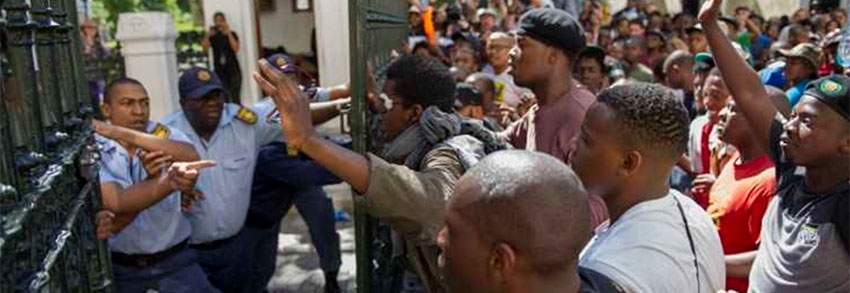A Step Forward
On 12 March 2015, an open-air dialogue took place on the stairs of Jammie Plaza, focal point of the UCT Upper Campus, to discuss the Rhodes statue, with arguments from all sides articulated. The following week, a march to the UCT administrative building, Bremner, took place, demanding a date for the removal of the statue. Later that month students stormed the Bremner building during a speech by Price addressing the removal of the statue. On 22 March, it was reported that the students were still occupying the building and that members of the public were supplying them with food. The protesters renamed the building Azania House. UCT's senate voted in favour of the removal of the statue on 27 March 2015, and following the vote, the statue was boarded up pending final decision of the university's council. On 9 April 2015 the Rhodes statue was removed.
As the agitation around the statue gathered momentum, protests quickly spread to nearly all of South Africa's universities. As well as the defacement of other statues, calls were made for the 'decolonisation of education'. The protests continued well into 2016 along with concomitant disarray. That year, examinations at UCT were postponed several times. Meetings called to deal with issues saw repeated disruption and senior members of staff and the UCT council were frequently shouted down. Campuses were being torn apart. Not all protests were violent or intolerant and a minority in many cases sabotaged what the majority was fighting for, but violence was a frequent accompaniment to the protests.
Things seemed to come together when students marched to parliament twice to call on government to do its bit. This happened at the Medium Term Budget Policy Statements in October 2015 and again in October 2016.The two events stood in stark contrast to each other, demonstrating both the depressing and the hopeful in our political culture. The depressing was on display in 2015: protesting students broke through barriers at parliament, entering the parliamentary precinct, and were met with police stun grenades and tear gas. As we watched live visuals on television, it felt rather like apartheid South Africa. The Zuma-led government made much of this 'storming' of the seat of government but in reality parliament had for too long been far removed from the people it is meant" to represent. The so called People's Parliament should sometimes get a taste of the people, surely? And they could surely also occupy the hallowed precinct? That day, then Minister of Higher Education Blade Nzimande cut a lonely figure as he tried in vain to address the students. His credibility was in tatters as he stood behind the railings holding a faulty loud-hailer. It seemed an appropriate metaphor for the circumstances. When it was clear that the students were uninterested in his platitudes, he hurriedly disappeared, along with other cabinet ministers, through the back entrances of parliament. Leadership was abdicated.
 Photo: Gallo Images / Beeld / Jaco Marais
Photo: Gallo Images / Beeld / Jaco MaraisA year later, in October 2016, when the students again converged on parliament, then Finance Minister Pravin Gordhan showed real leadership by stepping outside and meeting with student protesters. By addressing them, he managed to calm the crowd when tension was at its peak. It was quite a contrast to the previous year, yet Zuma was still in power and state capture was occupying everyone's mind. With the coffers increasingly bare as a result of corruption, where would money be found to deal with the students' demands, I wondered. The two marches represented a step forward in that students again took their protest to a seat of state power: parliament. For this effectiveness to be sustained, however, students would have had to connect the dots between rampant corruption and the failure to fund higher education as well as other socio-economic priorities. This unfortunately did not happen and overwhelmingly protests and anger were targeted at university management, who were mostly powerless as regards budgetary decisions.
South Africa's Pandora's box, containing the shortcomings of our political settlement, was blown wide open during the #FeesMustFall protests, not least because they exposed the Zuma administration as unfocused on the real issues of governance and distracted by state capture and self-interest. In such an environment, where there is no leadership, debate is easily polarised and differences are accentuated. Public discourse becomes increasingly frayed and it is difficult to engage with complexity. Thus, in 2016, it seemed one was either 'for' or 'against' the students and there was no place for a middle way. Mature societies are perhaps better able to deal with their challenges through debate and persuasion. Yet, around the world we are witnessing the polarisation of debate between 'them' and ' us'. The United States is perhaps the best example of polarised debate between 'left' and 'right'. South Africa, however, is still a young democracy and what we say can therefore cause greater, more lasting damage to institutions and society than in more resilient, developed democracies.
Share this page:Share this page:
Review of the 5th Parliament
Articles
- How does the PR system affect the quality of input in Parliament?
- Observing Parliament: my reflections
- A Constitutional Fiction: Parliamentary Oversight of the Executive
- Some thoughts on the Fifth Parliament
- Do small parties work for Parliament?
- View from the opposition benches
- Improving Parliament's ineffective oversight
- Parliamentary Advocacy: How to have an influence?
- Public Engagement: A Case Study
- Notes from the House
- Committee System: performance and areas of reform
- A step forward
- Why has Parliament not yet amended the Budget?
- Points of order (by an observer)
- Diary of a Parliamentary Nerd
